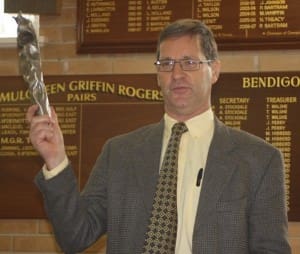AUSTRALIA’S wool growers and classers were doing a good job keeping contaminants out of clip oddments, but could be doing better, Victoria Wool Processors general manager David Ritchie said at the AWEX Wool Forum at Bendigo last week.
Mr Ritchie said foreign matter levels in oddment wool were generally improving, but nylon, rag and skin contamination were still big problems.
“Probably one out of every 20,000 bales you would find something coming through and really what it all comes back to is care in the shearing shed.”
But he said contamination like pieces of metal caused problems, breaking spikes on opening rollers. It cost about $2000 an hour to run the mill and a piece of metal recently shut operations down for an hour.
Mr Ritchie said the incidence of bales being used as bale dividers was not improving.
“These are a definite no-no…yesterday’s paper is far better, it costs you nothing.”
The bale dividers shred in the machinery and nylon is spread through the wool, he said.
“This is not improving, it is probably staying the same — this is one I really would encourage you to get rid of.”
Several years ago it took about three months to pick a shredded nylon bale divider out of wool valued at $150,000, he said.
“If you could take just a little bit of care in the shearing shed it would save us a lot of money.”
Mr Ritchie said the rag content in bales was also not improving and baling twine caused major problems for VWP.
Skin in wool is a major problem for industry
Skin was also a big contaminant in wool oddments, especially in lambs lines, Mr Ritchie said.
“It is a major, major problem.”
In 2005, carbonising lambs was about 35 per cent of VWP’s business, but it is now about 5pc, he said.
“Skin is the same protein as wool so chemically I can’t get rid of it and mechanically I can’t get rid of it; it has to be hand-picked out.”
VWP could not afford to pay people to pick skin out and when China started carbonising wool in the early 2000s they could afford to pick skin out wool.
“Reportedly they had one person, one bale, one day.
“We lost a lot of money because of the amount of skin in lambs wool.”
Chinese complaining about skin levels
Mr Ritchie said the Federation of Australian Wool Organisations had received a letter of complaint from China about the increasing levels of skin. He suspected with increasing labour costs the number of pickers had been cut back.
“I suspect it (skin contamination) is about the same and a lot of improvement would help everyone, but I don’t actually think it is getting worse.”
Mr Ritchie said correct clip preparation was part of the equation for growers aiming to realise premiums for their oddments at auction. VWP did not buy wool direct from growers, he said.
“We buy at auction — If you want to get a good price for your wool, send it to auction.”
VWP was the 11th biggest wool buyer in Australia, but one of only three early stage wool processors left in Melbourne.
“In 2000, there was something like 21, China has basically taken it all up.”
VWP closed its scouring plant in December, but now processes about 60,000 bales a year through its carbonising plant.


Three of four points in this article quoteing David Ritchie, don’t jell with me.
1/ He is quoted as saying. ” Probably one out of every 20,000 bales you would find something coming through”. With such a low number he should be over the moon. I think he may have meant 20,000 kilograms or 120 bales greasy, which would have been closer to the mark, but still a bit above, in my experience .
2/ A piece of metal that Mr Ritchie is holding, breaking a few spikes on the opening rollers is no big deal, turn the rollers backwards take the metal out, a couple of minutes, continue minus a few spikes till the next maintenance period.
3/ Bale dividers are only in mixed bales for bulk classing, why is mixed bale going straight into the line? If it was seen why wasn’t it pulled out, if it wasn’t seen how does Mr Ritchie know it was a divider. Bale caps have not been around for nearly forty years.
4/ I agree with Mr Ritchie, skin pieces are no worse and probably less with plainer bodied sheep today, but the Chinese must always have something to whinge about.
When wool is tipped into the infeed of a scour or carbonising plant with a forklift, it is not a quality job. woolman.biz
My 17-18 micron wool, superbly prepared, ends up going overseas and being blended with rubbish from Fibre Direct types who have no one in their sheds and then these guys complain.